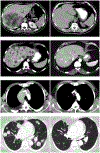IL-2: the first effective immunotherapy for human cancer
- PMID: 24907378
- PMCID: PMC6293462
- DOI: 10.4049/jimmunol.1490019
IL-2: the first effective immunotherapy for human cancer
Abstract
The ability of IL-2 to expand T cells with maintenance of functional activity has been translated into the first reproducible effective human cancer immunotherapies. The administration of IL-2 can lead to durable, complete, and apparently curative regressions in patients with metastatic melanoma and renal cancer. The growth of large numbers of tumor-infiltrating lymphocytes with in vitro anti-cancer activity in IL-2 has led to the development of cell transfer therapies that are highly effective in patients with melanoma. The genetic modification of T cells with genes encoding αβ TCRs or chimeric Ag receptors and the administration of these cells after expansion in IL-2 have extended effective cell transfer therapy to other cancer types.
Conflict of interest statement
Disclosures
The author has no financial conflicts of interest.
Figures


References
-
- Morgan DA, Ruscetti FW, and Gallo RG. 1976. Selective in vitro growth of T lymphocytes from normal human bone marrows. Science 193: 1007–1008. - PubMed
-
- Gillis S, and Smith KA. 1977. Long term culture of tumour-specific cytotoxic T cells. Nature 268: 154–156. - PubMed
-
- Rosenberg SA, Schwarz S, and Spiess PJ. 1978. In vitro growth of murine T cells. II. Growth of in vitro sensitized cells cytotoxic for alloantigens. J. Immunol 121: 1951–1955. - PubMed
Publication types
MeSH terms
Substances
Grants and funding
LinkOut - more resources
Full Text Sources
Other Literature Sources
Medical

